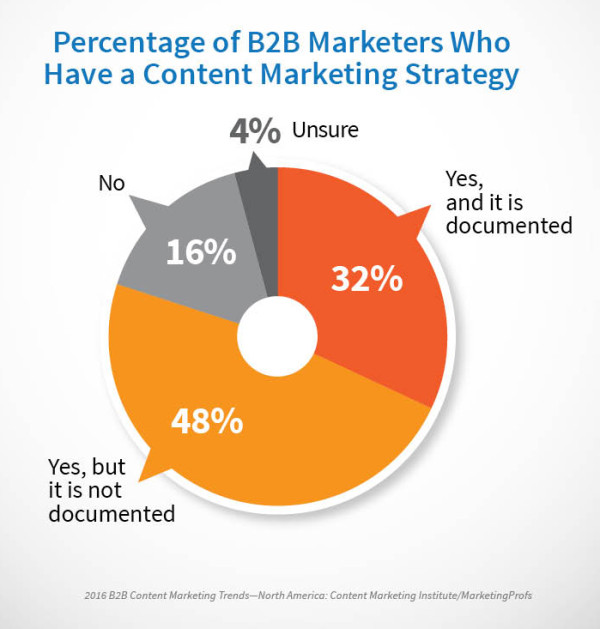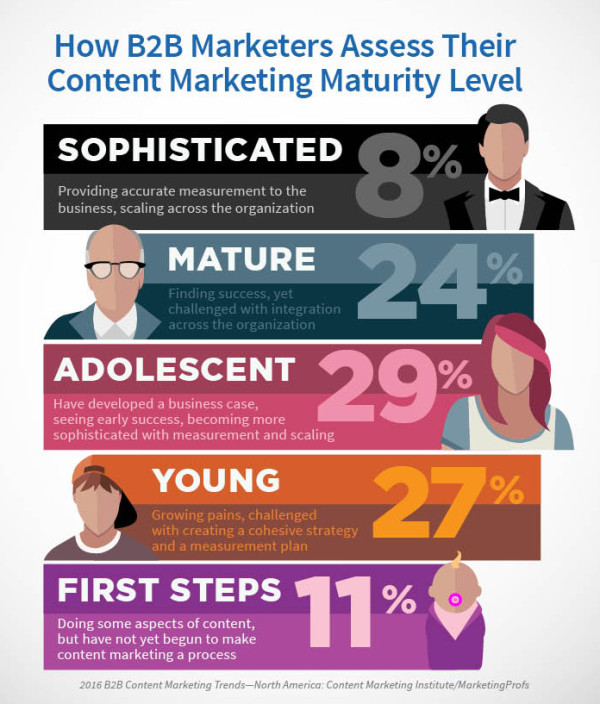
Whether your business resides in the B2B (business-to-business) or B2C (business-to-consumer) space, content marketing in 2016 is almost certainly one of your top priorities (and if it isn’t, then you need to remedy that pretty sharpish).
Indeed, a recent study from the Content Marketing Institute found that a whopping 88% of B2B marketers use content marketing as part of their marketing strategy. I have to say that I was relieved and encouraged when I read that stat, for it clearly indicates that the overwhelming majority of marketers already understand the modern importance of the practice.
My delight was short-lived, however. For, upon reading the remainder of the article, it was revealed to me that whilst a very pleasing 88% of marketers are using content marketing, only 32% of these have a documented content marketing strategy.

Image source: Content Marketing Institute
Does Having A Documented Content Marketing Strategy Make A Difference?
Yes.
Documenting your content marketing strategy provides you with a figurative map and compass which can be used to steer your business towards success. Without one, you are simply driving in the dark without headlights. Granted, you may eventually get to where you want to be like this, but the avoidance of obstacles cannot be guaranteed, and your vessel will most likely suffer damage on the journey.
I don’t like making wild claims without evidence to back it up, mind you, and so once again let’s turn to the Content Marketing Institute’s study.
The research found that the more sophisticated/mature a company’s content marketing strategy, the more effective the results. Take a look at their infographic and then consider the statistics below:

Image source: Content Marketing Institute
- 64% of marketers in the sophisticated/mature stage found their strategies to be effective
- 23% in the adolescent phase felt it was working
- And only 6% in the young/first steps phase believed their content marketing efforts to be valuable
The correlation is therefore simple – the more sophisticated your content marketing strategy, the more effective the results.
How To Write An Effective Content Marketing Strategy
Writing a content marketing strategy may appear intimidating, but, as the statistics show, it is necessary if you want all of your content marketing efforts to pay off.
The good news is that the writing of an effective content marketing strategy isn’t as difficult as it may first appear. In fact, the process can be a lot simpler than actually creating the content itself – although, having said that, when you’ve got a solid content marketing strategy, content creation becomes a lot easier, so it’s a win-win situation all round.
So let’s now walk through exactly what you need to start building a strategy that will put you in great stead for content marketing success.
1- Define Your Goals
What are the ultimate goals of your content marketing plans?
In the first instance, increasing your SEO (search engine optimization) will almost certainly be at the top of your list – the more content you create, the higher you will find yourself on SERPs (search engine results pages), and the higher you are on SERPs, the more discoverable you are.
But, beyond brand awareness, what are your other goals?
Improving your credibility and status as an industry authority may also be a priority – so you will be wanting to create lots of content that positions you as an expert in your field.
What else? Do you have a mission statement?
Perhaps you’re selling some sort of product that aims to get young people out and about more. In this case, your mission statement might be something like “[Brand name] seeks to improve the physical health and fitness of young people in a fun and exciting way.”
With your goals set, you can begin to understand more clearly exactly who your target audience is, and from there work out the content that will most appeal to them.
2- Create Client Personas
Your client personas are fictional renditions of your ideal customer.
So, using the above example, your two main client personas are likely to be the parents of the young people you want to use your product, and the young people themselves.
But, you will need to refine these personas a little more. Does your product appeal to boys or girls the most? And is it mums or dads that you want to target?
Other things like age, physical ability and even household income are important – is your product top-of-the-range, for instance, and very expensive, or is it more affordable?
Once you know these things, you can start researching.
3- Research Your Audience
So, you’ve developed your client personas – now you need to work out where these types of people hang out online, and what sort of content they are most likely to engage with.
Are they most likely to be found on Facebook or Instagram? Perhaps they’re all over Pinterest, or possibly Twitter?
A great way to determine this is to do some spying on your competitors – where are they posting their content, and how much engagement is it getting?
4- Decide On Formats
Your audience research will almost certainly reveal to you that you will need to be creating different types of content to target your different personas across different marketing channels.
You may realize that whilst parents are showing willing to read and share your blog posts across Twitter, the young people are only really interested in videos on Facebook and Instagram. Take note, and forge your strategy accordingly.
5- Draw Up An Editorial Calendar
By now, you will have a pretty clear content marketing strategy – you know what types of content you will be creating, for whom, and where you will post them. All that you need to do now is accept that you cannot and should not post everything at once, and so draw up an editorial calendar that will track your output over the coming weeks and months.
You will of course need to heed of your resources – writing three blogs a week may sound like the best idea, but if you’re working on your own and need to make time to create video content, infographics, and engage with your following across all of your social channels, then you’re going to have to have a rethink.
Consistency is key, however. If you’re going to focus on a regular blog, then make it regular – post at the same time on the same days of the week, as this way your audience will get to know when and where they can expect new content from you.
Final Word
I’m afraid to say that making a content marketing strategy is a never-ending process. You will almost certainly find that some elements of your strategy are not paying off as well as you thought they would when you first started them.
This is fine – so long as you adjust your strategy accordingly. The great thing about having a documented content marketing strategy is that you can use it to track your successes and failures. Indeed, keeping yourself informed as to the performance levels of each piece of content that you post will help you make improvements for your future campaigns.
The only other thing to say is that make sure that you promote all of the content that you put out thoroughly and consistently. Share across social media, make sure that you engage with all comments that are left, and thank all likers. With this, you are sure to keep your audience engaged, which should always be one of the key goals of your content marketing efforts.
Good luck, and happy strategizing!





